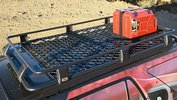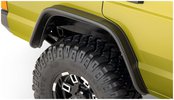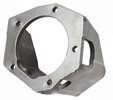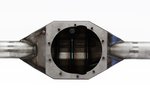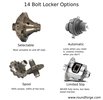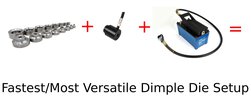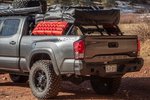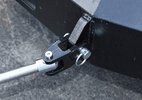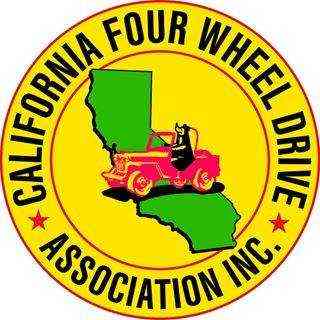Pick a Pitman: All About Stock and Aftermarket Toyota Pickup and 4Runner Pitman Arms

- 4 Ways to Adapt Toyota IFS Steering to Toyota High Steer
- How to Properly Install and Maintain Toyota Steering Arm Knuckle Studs
- Trail-Gear flat pitman arm- This pitman arm is forged and has an FJ80 TRE taper.
- Sky Manufacturing flat pitman arm - They machine chromoly pitman arms with GM taper, FJ80 taper, or a 3/4 hole for a heim joint.
- Toyota 2WD 3rd Gen Pitman Arm - 3/4" drop, 3/8" shorter than stock, FJ80 TRE taper, but two areas need to be filed to fit splines of IFS box.
- Toyota FJ80 pitman arm - Curved and slightly clocked when mounted. Has FJ80 TRE taper.
- Sky Manufacturing 3/4" less than stock drop pitman arm - A machined chromoly pitman arm with 3/4" less drop than stock.
- Use a forged Toyota drop pitman arm. Fits the FJ80 TRE taper.
- Use a tapered insert with an IFS pitman arm. Welding is required. Fits the FJ80 TRE taper.
- Use an adapter with an IFS pitman arm. Bolts on and uses 23mm FJ80 TRE thread.
- Loosen the pitman arm nut with a 32mm socket.
- After you loosen the nut, put tension on the pitman
arm with the pitman arm puller. Pullers are pretty cheap and you can
also do free rental from some auto parts stores.
- The pitman arm usually doesn't come free, so take a small sledge hammer and smack the side of the arm where the splines are to get it to pop loose. Don't hit the steering box or the nut. Usually, tension plus a hammer will do the trick.
- As a last resort, you can heat the pitman arm where the splines are. Be very careful not to fry the sector shaft seal coming out of the steering box.
- Try pre-lubricating the pitman arm splines the day before you do the work. We like equal parts ATF mixed with acetone.
- Don't crank the puller until it breaks, because it's not hard to break a puller.
- Keep the threads of the puller lubricated.
- Tighten the puller, then hit the pitman with the hammer, then repeat until the pitman comes off. This should work for most people.
Why do you need to know about pitman arms? If you spend any time off road, you’ll eventually put high steer on your truck. If you can, you’ll ideally install a high steer system in which all the components are designed to work together. However, you might end up piecing something together yourself in which case you need to know about the available options.
Quick Toyota Pitman Arm Info
If you just want the quick low-down and where to get these things, here you are:
Toyota Flat Pitman Arms
These are available from two manufacturers:
Toyota Moderate Drop Pitman Arms
These are 3 of these available that we know of:
Toyota Long Drop Pitman Arms
There are basically 3 ways to do this:
Toyota Pitman Arms and High Steer
We are mostly interested in pitman arms that mount on 1986-1995 Toyota IFS steering boxes. This is because earlier solid axle Toys used push-pull steering which is unsuitable for high steer setup - generally early Toyota owners will swap in a Toyota IFS steering box so that's what we're looking at here. Whether you have a solid axle or IFS Toyota, you’ll likely want to use the IFS steering box. The IFS steering box is strong enough to do the job and the sector shaft rotates the pitman arm in the correct arc.
Regular rotation steering boxes vs. Reverse rotation steering boxes
While the Toy box has a rear swing pitman arm (points backward), some have installed front swing steering boxes like the Scout II Saginaw box. The main benefit to this is probably the fact that some Saginaw boxes are incredibly common and came with a wide variety of pitman arms that have different lengths and drops. A box like this can also keep the steering box out of the front body mount if you move the box forward to complement a forward-mounted axle.


The pitman arm points to the rear, as with a Toyota IFS pitman arm. The drag link tends to end up under the steering box.
The pitman arm points forward, as on FJ60 and International Scout II Saginaw boxes. The drag link tends to end up in front of the steering box.
A reverse rotation steering box works well when you really want to push your front axle extremely far forward, which is usually the case when you want to keep big tires out of the firewall. To get your axle forward, you also need to move the box forward to maintain decent steering linkage angles. Many fabbers push the box forward and trim the body mount to fit everything together. With the drag link hanging under the rear of the steering box, this can be an annoying compromise. A reverse rotation box puts the drag link in front of the steering box which can make things a little easier to fit on extreme rigs.
Why choosing the right pitman arm for your Toyota is important
The clearances between tires, axles, leaf springs, and the frame on your Toyota can be pretty tight. If you want a low center of gravity (and you do if you spend time off road), things get even tighter. Most people relocate their IFS steering box with a weld-on kit at the very least.
Some owners notch their frame for to clear the drag link nut on the pitman arm (to keep it away from the leaf spring), trim the forward body mount, and other little tricks to get as much clearance as possible. Some of this has to do with steering clearance and some of it has to do with keeping large tires out of the firewall. The point is that you want to try to do this stuff only once, and the lower you want your rig, the harder it is.
Many clearance problems can also be solved by going to a link suspension and/or hydro steering.
Toyota Pitman Arm Removal
Before pulling off the pitman, look at the underside.
You should have marks on the sector shaft that line up with marks on the pitman arm. Don’t have them? Make them with a punch. When the steering box is centered, meaning that the number of turns to the left equals the number of turns to the right, the sector shaft marks will point straight ahead.

When the steering box is centered and the marks are aligned, your pitman arm is properly installed. These marks are common on other Toyota models.
The pitman arm is secured to your steering box’s sector shaft with a large nut. The Toyota pitman arm nut size is 32mm. You need:
A couple of tips:
Toyota Pitman Arm Installation
Our biggest recommendation when reinstalling any pitman arm is to use a new nut. This eliminates problems with thread stretch, thread mangling, and excessive heat application if you had to torch your pitman. What you’re trying to do here is eliminate the possibility of the nut backing off due to imperfect threads. The factory torque spec on the Toyota pitman arm nut is 130 ft-lbs.
Don't be a dummy
If you install your Toyota's pitman arm without torquing it, your pitman arm will fall off. This would be a dumb, easily-preventable accident. Do you want people to think you're an idiot? Because if your pitman arm falls off, people will think you're an idiot.
Toyota Pitman Arm Dimensions and Specs
| Vehicle | Taper | Length | Drop | Notes |
|---|---|---|---|---|
| 1986-1995 Toyota mini trucks | NA | 5.8" | large | No drag link taper, ball joint insert |
| 1986-1995 Toyota 4Runners | NA | 5.8" | large | No drag link taper, ball joint insert |
| 1980-1990 Toyota FJ60s and FJ62s - longer arm than ifs | Same taper as FJ80, BUT deeper=larger hole | 7" | large, 3.75" | Drag link hole too large for FJ80 TRE |
| 1993-1998 Toyota T100s | NA | No drag link taper, ball joint insert | ||
| 1993-1998 Toyota FJ80s and FZJ80s | FJ60 tie rod end, FJ80 tie rod end | 5.95" | small | Pitman arm is curved because it would interfere with the panhard bar bracket. Has index mark. Is clocked when mounted. |
| 3rd Generation Toyota 2WD with power steering (poss. 1 ton) | FJ80 tie rod end | 5.375" | small | Requires filing 2 flat areas on splines to fit on the IFS power steering box. |
| Sky Manufacturing | FJ80, GM "1 ton", 3/4" heim | 3/8" less than stock IFS | flat | 4340 Billet Chromoly |
| Sky Manufacturing | FJ80, GM "1 ton", 3/4" heim | 3/8" less than stock IFS | 3/4" less than stock | 4340 Billet Chromoly |
| Marlin Crawler | FJ80 | Stock IFS | large | Forged |
| All Pro | FJ80 | Stock IFS | large | Forged |
| Trail-Gear | FJ80 | Stock IFS | large | Forged |
| Trail-Gear | FJ80 | Stock IFS | flat | Forged |
Toyota Pitman Arm Design
Toyota pitman arms have 48 splines. While similar spline counts and sector shaft diameters mean that many Toyota pitman arms may interchange between models, hooking up drag links is another story.
‘86-‘95 minis and 4Runners and all T100s have a slightly unusual design for the drag link end of the arm. While most pitman arms off-roaders use have a tapered hole that accepts a tapered drag link end, this one has a ball joint (just like the drag link end) that mates with a hole in the drag link. It’s just a role reversal, got it? Unfortunately, this design needs to be dealt with if you’re piecing together your own high steer kit. We have the specifics on adapting IFS steering boxes to Toyota high steer.

You can press out the ball joint, however it leaves a huge hole that no tie rod end would ever fit. There are inserts that can be welded into the hole to fit an FJ80 TRE.
60 Series Land Cruisers have a drop built in but also an inconvenient deep taper and so the arm is often swapped for something else that will fit an FJ80 tie rod end. It is highly unlikely that you can safely and reliably shim a 60’s relay rod hole to fit an 80 Series TRE.
FJ80/FZJ80 arms will fit the ubiquitous FJ80 tie rod end.
Material
Aftermarket arms are usually either forged steel or chromoly. Chromoly pitman arms tend to bring the beef. While wheelers have bent stock and aftermarket forged pitmans, the Sky pitman arm has proven to be fairly indestructable. It is the only billet 4340 chromoly pitman that we know of that is readily available and should be in your pile of parts if you need seriously strong stuff.
Taper
The universal aftermarket taper for Toyota tie rod and drag link ends is that found on the Toyota Land Cruiser FJ80 tie rod end.
There are right hand and left hand threaded versions of this tie rod.
This tie rod end is easy to get, has a short shank, good misalignment
angles, and is relatively large. This tie rod end controls the FJ80
which is basically a whale on wheels (a whale that we love) so it should be strong enough for most wheelers.
However, some people like to use what is known as the GM 1 ton tie rod and drag link ends. They're bigger than the FJ80 parts and you may need to buy a tapered reamer for your steering arms and pitman arm. The GM ends have a 7/8" thread and the GM drag link ends are high misalignment. You can order a Sky pitman with a GM taper or do it yourself with another manufacturer's arm. RuffStuff has confirmed that their drop pitman arm has enough material to accept the larger GM taper.
If you plan to build a pitman arm, make your own steering arms, or need to modify an existing arm you’ll need a taper reamer which is available for $40-50. Along those lines, there are plenty of fab shops that will do this for you.
The FJ80 tie rod end taper is:
1.200" TPF
(1.200" of taper for every foot of length)
which is also expressed as:
1:10 (1" of taper for every 10" of length)
The FJ80 tie rod end thread is:
23mm-1.25M

This is the tool you need to create the correct taper for FJ80 tie rod ends. It can be run in a drill press or by hand.
Pitman arm tapers in Toyota high steer kits
FJ80 tie rod ends are used in most high steer kits for solid axle Toyotas, including 40s, 55s, and 60s. Consequently, your pitman arm also needs the FJ80 taper. One of the other benefits to the 80 Series TRE is that everyone has them which means that there should be plenty of spares on a typical trail ride.
Length
All high steer kit manufacturers match pitman arm length to steering arm length. Why? A too-short pitman arm or too-long steering arms will result in your steering box running out of travel before you hit full steering lock at the axle - your knuckles will never hit the steering stops on the axle because the steering box will already be hitting its internal stops. This is the origin of “My knuckles are a 1/2” from the stops” posts on bulletin boards and 32-point turns on the trail. If your turning radius sucks, pay close attention to this section.
How to measure length
Length is always measured on a pitman arm at a right angle to the sector shaft hole. Length is measured from the center of the sector shaft hole to the center of the drag link hole. This measurement is sometimes referred to as “radius” since the pitman arm swings in an arc.

Measure from the center of the the splines to the center of the taper. The measurement should be perpendicular to the sector shaft hole.
Length of the pitman arm is very important. It needs to translate the rotation of the steering box into a push-pull motion that acts on the steering arms (and is again translated into rotation). A shorter pitman arm has less swing and thus creates a shorter push-pull.
How pitman arm length affects your steering
Imagine 2 concentric circles (one circle inside another circle). The bigger one is 12” in diameter and the one inside it is 10” in diameter. The 10” circle represents the path of a 5” long pitman arm. The 12” circle represents the swing of a 6” long pitman arm. This means that from side to side the 6” pitman arm moves the drag link 1 more inch on each side. The 6” arm can push or pull the drag link 2 extra inches!!! Meanwhile, the 5” arm has a shorter throw, has a shorter push-pull motion, and might not move the steering arms enough to give you a decent turning radius.
Okay, so just because the drag link moves 2” more, does that mean the knuckles move 2” more at the steering stops? No! Of course not! The steering arms also swing in an arc and are subject to the same swing geometry as the steering arm. Only here, the length affects the movement in an opposite manner.
You must pay attention to this if you’re putting your high steer together piecemeal, and especially on a Toy! Since the mounting of the steering box is often dependent on the pitman arm placement, and the placement of the pitman arm is usually extremely close to the frame on a solid axle swap, you need to do stellar mockups and clearance testing before welding anything in. Correcting frame or box-mounting issues later can be painful.
To summarize how lengths affect how your steering handles:
| Change | Turning radius | Steering "speed" | Steering effort |
|---|---|---|---|
| Longer pitman arm | Allows full available turning radius | Faster | More |
| Shorter steering arms | Allows full available turning radius | Faster | More |
| Shorter pitman arm | May limit available turning radius | Slower | Less |
| Longer steering arms | May limit available turning radius | Slower | Less |
Steering effort
When we refer to steering effort in the above table, you should know that it’s pretty irrelevant. Most of us are running power steering and the increase or decrease in steering effort will be negligible and probably not too noticeable.
Steering speed
Steering speed is how fast we can get lock to lock. This is faster with a longer pitman arm because it travels more distance with each turn of the steering wheel than a shorter pitman arm.
Be wise when referring to the above table.
A longer pitman arm gives you a better turning radius over a shorter arm, but that really just means that the shorter pitman arm was undersized. A long pitman arm can be bad too! As an exaggerated example, if you put a 6 foot pitman arm on your Toy, you’d be able to go to full lock just by twitching your wrist! Not so good for the highway.... Pitman arm lengths have tradeoffs!
Drop
What is a drop pitman arm?
This is not a clearly defined term. We think drop should be measured vertically from the top of the splined side to the bottom of the drag link side. This seems like a pretty good method since most people will mount the drag link on the bottom of the pitman and it eliminates the concern of how thick the pitman material is. With this measurement a flat pitman arm would have a “drop” essentially equal to the material thickness.

We think this is a good way to measure drop. When the splined end is seated on the sector shaft, we can know where the drag link will be without worrying about the pitman's material thickness.
Available Toyota pitman arm drops
In order to have a low lift with a SAS look at flatter pitman arms first. While you can use a stock drop pitman, you may have to tilt your steering box a bit to keep spring off the drag link. Large pitman arm drops tend to go with large lifts that have a lot of space between the spring and frame.
Flat arms are only available in the aftermarket from Sky and Trail-Gear.
Moderate drops are provided by the 2WD 3rd Gen w/power steering arm, the Sky Manufacturing 3/4”-less-than-stock-drop chromoly arm, or the FJ80 pitman arm.
Longer drops can be had with a stock Toyota IFS arm plus insert or an aftermarket arm like RuffStuff's Toyota pitman arm.
Note that while the FJ60 has a significant drop, it has a large hole that will not fit the FJ80 TRE taper. If you buy a hi-steer kit for a 60 Series, you’ll get a “generic” pitman arm that fits an FJ80 TRE.
Possible Toyota Pitman Arm Combos
If you stick with Toy parts, you can have bolt-on parts by running 1 item from each column.
| Steering box | Pitman arm | Steering link end |
|---|---|---|
| '86-'95 IFS Toyota OR FJ60/FJ62 OR FJ80 |
'86-'95 Stock Toyota IFS | Sky Manufacturing adapter to any FJ80 thread drag link |
| Sky Manufacturing billet chromoly arm, 3/4" less than stock drop | FJ80 TRE, GM "1 ton", or 3/4" heim | |
| Sky Manufacturing billet chromoly arm, flat | FJ80 TRE, GM "1 ton", or 3/4" heim | |
| FJ80 pitman arm, moderate drop | FJ80 TRE | |
| Forged pitman arm from Marlin, Trail-Gear, or All-Pro; stock drop | FJ80 TRE | |
| Trail-Gear forged arm, flat | FJ80 TRE |
Last updated: September 5, 2019
